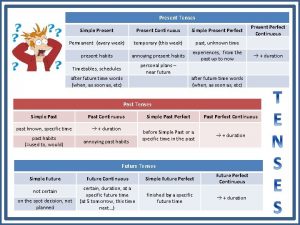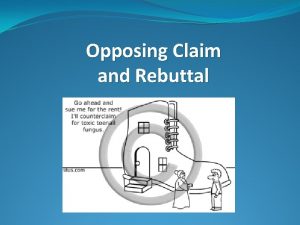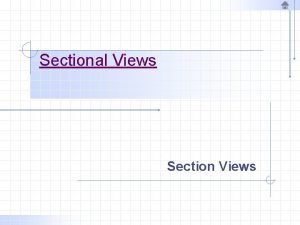OPPOSING VIEWS WHY SHOULD I PRESENT THE OPPOSING














- Slides: 14

OPPOSING VIEWS

WHY SHOULD I PRESENT THE OPPOSING SIDE? Does including opposing arguments weaken your essay? Including opposing arguments: Strengthens your credibility � Interested in finding the truth � Knowledgeable � Fair Addresses the reader’s objections Can help fuel your argument

WHAT ARE OPPOSING ARGUMENTS? Arguments against a claim, evidence, or explanation. � (Explanation: interpretation of evidence or explanation of how evidence proves claim). Degrees of (Dis)Agreement Completely Agrees Partially (Dis)agrees Disagrees Practice: Argue against this claim, evidence, and explanation. � College students should participate in athletics. � 80% of college athletes earn above a 2. 5 GPA. � Therefore, being involved in athletics helps students become academically successful.

HOW CAN I FIND OPPOSING ARGUMENTS? Identify the Most Important Opposing Arguments Start with the opposing arguments that first come to mind. � Identify opposing arguments to your main claims Consider your audience and the opposing side—Who are they? What do they believe? What do they want? Why? � What might they argue? Identify More Subtle Opposing Arguments Find other opposing arguments by identifying your claims, evidence, and explanations. Ask yourself, how might a reasonable person argue against this? Try negating or partially negating your claims, evidence, and explanations. Think of counterexamples. Check your opposing arguments by asking, “Would a reasonable person argue this? ” and “Does this opposing view need to be addressed? ”

TIPS Don’t just list multiple counterarguments. Consider a few of the most relevant counterarguments in some depth.

HOW SHOULD I ADDRESS OPPOSING ARGUMENTS? Two Ways: Prevent Opposing Arguments 1. Add enough details and explanations so the reader doesn’t have any objections Present and Respond to Opposing Arguments 2. § § Introduce opposing arguments and respond to them Although opponents may believe X… Proponents of this bill argue X because of Y; however… How will you decide which approach to use?

HOW SHOULD I PRESENT OPPOSING ARGUMENTS? Be specific and provide the reasons for their claims. Be brief—don’t emphasize or support their points too much. Be fair—take counterarguments seriously; do not belittle them. Respond immediately to opposing arguments.

HOW SHOULD I RESPOND TO THEOPPOSING SIDE? Should you ever concede to an opposing argument? 1. Concede, BUT show why the audience should accept your argument anyway. 2. Partially refute the counterargument—“yes, sometimes…” and show why the audience should accept your argument. 3. Completely refute it— show why the counterargument is mistaken.

WHAT IF I CAN’T REFUTE OPPOSING ARGUMENTS? Consider qualifying or changing your claim! Be open-minded

WHERE SHOULD THE COUNTERARGUMENT GO? The Intro: Introduction Opposing Arguments Thesis The First Body P: Introduction General statements Thesis Body Par 1 Body Claims, evidence, and explanations that support thesis and refute opposing arguments Opposing Arguments and response Multiple Body Pars Claims, evidence, and explanations that support thesis Conclusion Wrap up General statements Every Body P: The Last Body P: Introduction General statements Thesis Body Par 1 Opposing Arguments Claims and evidence Body Par 2 Opposing Arguments Claims and evidence Conclusion Wrap up General statements When would you use each of these? General statements Thesis Multiple Body Pars Claims, evidence, and explanations that support thesis Last Body Par Opposing Arguments and response Conclusion Wrap up General statements

PRACTICE: THE DOUBTING GAME Part 1: Reading Skeptically Switch papers with a partner. Read his/her essay as a skeptical reader (even if you actually agree). � Write opposing arguments, questions, and counterexamples. Part II: Selecting Arguments Read through the opposing arguments and concerns written on your essay. Decide which to include in your essay by asking yourself: “Is this important for me to include and respond to? � “Would a reasonable person argue this? ” � Decide how you’ll respond: preventing or presenting

AN EXAMPLE… Hybrid cars are an effective strategy to fight pollution. � Internal combustion engines cause a great deal of air pollution. Driving a private car is a typical citizen's most air polluting activity. � Hybrid cars combine a gasoline engine with a battery-powered electric motor, which means that less pollution is produced. � Cars generally have a long lifespan, meaning that a decision to switch to a hybrid car will make a long-term impact on pollution levels. � Hybrid cars are an effective strategy to fight pollution.

PRACTICE: DIALOGUE 1. Review your main point and supporting points. 2. Write a dialogue between you and your opposing side. • What will you argue? • How will they respond? …

Chart � Claim/evidence Counter claim/evidence Response/refutation In-class essay on the opposing side
 Persuasive techniques in speeches
Persuasive techniques in speeches Hey bye bye
Hey bye bye Dont ask
Dont ask Full section view engineering drawing
Full section view engineering drawing Present opposing arguments or evidence
Present opposing arguments or evidence Present perfect present simple present continuous
Present perfect present simple present continuous Difference present perfect simple and continuous
Difference present perfect simple and continuous Present perfect continuous cand se foloseste
Present perfect continuous cand se foloseste Which verb tenses describe continuing action?
Which verb tenses describe continuing action? Present simple perfect
Present simple perfect Present simple present continuous present perfect
Present simple present continuous present perfect Present simple present continuous and present perfect
Present simple present continuous and present perfect Hình ảnh bộ gõ cơ thể búng tay
Hình ảnh bộ gõ cơ thể búng tay Ng-html
Ng-html Bổ thể
Bổ thể



























